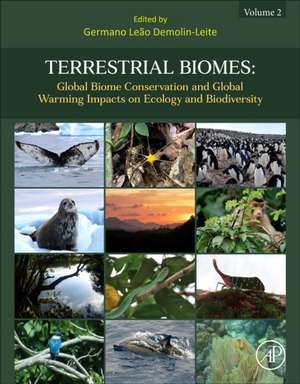Terrestrial Biomes: Global Biome Conservation and Global Warming Impacts on Ecology and Biodiversity
Editat de Germano Leão Demolin-Leiteen Limba Engleză Hardback – apr 2025
This is an important resource for students, professors, researchers, and governmental and non-governmental organizations active in biodiversity conservation and climate change mitigation.
- Discusses the decline and conservation of the world's major terrestrial biomes
- Provides the use of ecological indicators to analyze the conditions of terrestrial biomes with a global perspective
- Spans desert, Mediterranean, grassland, forest, subterranean, taiga, and tundra biomes
- Highlights the work of researchers whose expertise includes insular biomes, prairies, shrublands, steppes, taiga, tundra, and global warming perspectives
Preț: 1200.05 lei
Preț vechi: 1318.73 lei
-9% Nou
Puncte Express: 1800
Preț estimativ în valută:
229.63€ • 250.21$ • 193.50£
229.63€ • 250.21$ • 193.50£
Carte nepublicată încă
Doresc să fiu notificat când acest titlu va fi disponibil:
Se trimite...
Preluare comenzi: 021 569.72.76
Specificații
ISBN-13: 9780443365690
ISBN-10: 0443365695
Pagini: 600
Dimensiuni: 216 x 276 mm
Editura: ELSEVIER SCIENCE
ISBN-10: 0443365695
Pagini: 600
Dimensiuni: 216 x 276 mm
Editura: ELSEVIER SCIENCE
Cuprins
Section I: Deserts
1. Antarctica Desert
2. Northern Great Rift Valley: deserts and otherbiomes
3. Ecosystem services in the Atacama region, Chile
4. Chihuahuan Desert
5. Simpson Desert
6. Indian Thar
7. Sahara and other African Deserts
Section II: Insular Biomes
8. Madagascar and Mauritius as Insular Biomes
Section III: Mediterranean
9. Mediterranean Basin
10. An Afromontane biome in South Africa:ecological quality of natural vs transformed habitats
Section IV: Prairies and Steppes
11. Prairies and Steppes: Cradles of GrasslandBiodiversity
12. European steppes and forest-steppes
13. American
Section V: Shrublands
14. Biodiversity and Ecological Dynamics of theFynbos Biome in South Africa
15. Mediterranean Shrublands
16. Xeric Shrublands
Section VI: Savannas
17. Land degradation and its associated eff ects ondung beetle species in African Savanna
18. Asia
19. Australian Savannas
20. American Savanna: A brief review
Section VII: Subterranean
21. Subterranean
Section VIII: Taiga
22. Asia
23. North Europe
Section IX: Temperate Forests
24. Temperate forest of Asia in the wake of climatechange
25. Temperate forests at Southern South America:Challenges for management and conservation to faceclimate change
26. Europe Temperate Forests
27. North America
Section X: Tropical Forests
28. Conservation status of dung beetles(Scarabaeidae: Scarabaeinae) in African tropical forests
29. The use of phytotelmata by amphibians in theAmazon rainforest: A review and case study
30. Asia’s Ecological Tapestry: NavigatingConservation Challenges in the Era of Global Warming
31. Atlantic Forest
32. Biodiversity, function and change of tropicalrainforests of Borneo
33. Caatinga
Section XI: Tundras
34. Asian Arctic tundra: Vast permafrost ecosystemsunder increasing pressure by climate change and industrialdevelopment
35. The importance of Belarus tundra peat bogs forbiodiversity conservation in global warming condition
36. North American tundras: Imperiled landscapesat a continent’s latitudinal and altitudinal extremes
1. Antarctica Desert
2. Northern Great Rift Valley: deserts and otherbiomes
3. Ecosystem services in the Atacama region, Chile
4. Chihuahuan Desert
5. Simpson Desert
6. Indian Thar
7. Sahara and other African Deserts
Section II: Insular Biomes
8. Madagascar and Mauritius as Insular Biomes
Section III: Mediterranean
9. Mediterranean Basin
10. An Afromontane biome in South Africa:ecological quality of natural vs transformed habitats
Section IV: Prairies and Steppes
11. Prairies and Steppes: Cradles of GrasslandBiodiversity
12. European steppes and forest-steppes
13. American
Section V: Shrublands
14. Biodiversity and Ecological Dynamics of theFynbos Biome in South Africa
15. Mediterranean Shrublands
16. Xeric Shrublands
Section VI: Savannas
17. Land degradation and its associated eff ects ondung beetle species in African Savanna
18. Asia
19. Australian Savannas
20. American Savanna: A brief review
Section VII: Subterranean
21. Subterranean
Section VIII: Taiga
22. Asia
23. North Europe
Section IX: Temperate Forests
24. Temperate forest of Asia in the wake of climatechange
25. Temperate forests at Southern South America:Challenges for management and conservation to faceclimate change
26. Europe Temperate Forests
27. North America
Section X: Tropical Forests
28. Conservation status of dung beetles(Scarabaeidae: Scarabaeinae) in African tropical forests
29. The use of phytotelmata by amphibians in theAmazon rainforest: A review and case study
30. Asia’s Ecological Tapestry: NavigatingConservation Challenges in the Era of Global Warming
31. Atlantic Forest
32. Biodiversity, function and change of tropicalrainforests of Borneo
33. Caatinga
Section XI: Tundras
34. Asian Arctic tundra: Vast permafrost ecosystemsunder increasing pressure by climate change and industrialdevelopment
35. The importance of Belarus tundra peat bogs forbiodiversity conservation in global warming condition
36. North American tundras: Imperiled landscapesat a continent’s latitudinal and altitudinal extremes
